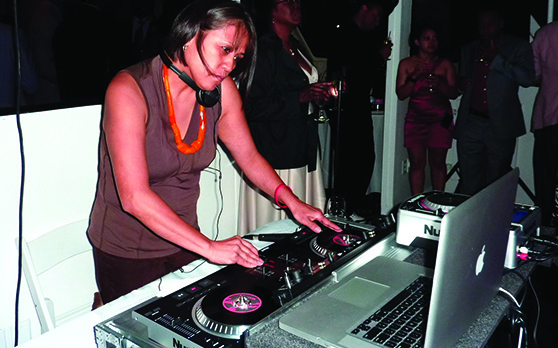
By Kalvin Valdillez, Tulalip News
“One of the primary joys I get from DJing comes from knowing that I can bring people out of what they’re going through,” expressed Tulalip Disc Jockey, Monie Ordonia. “If they’re worried or stressed, they can come and get lost in the music. They can release and be in the now moment, and not think about the later, because when you’re dancing, you’re not thinking about any of that.”
Like many Native American musicians, Monie has a special relationship to the rhythm, bassline, and drum beats. Traditionally, Natives are brought up with a deep respect and love for music as certain songs and chants are held in high regard and are only brought out for special occasions. This practice is embedded in the DNA of countless tribal members. Over the years, music has served as good medicine that has helped many through heartbreak, grief, and battles with addiction. On the flipside, music has also amplified the joyous times, and people often tie happy memories to songs of that specific moment in time.
DJ Monie developed a strong connection, a thorough understanding, and an undying passion for music at a young age. Growing up off-reservation, in the central district of Seattle, Monie’s appreciation and respect for music has always been on par with her ancestral ways.
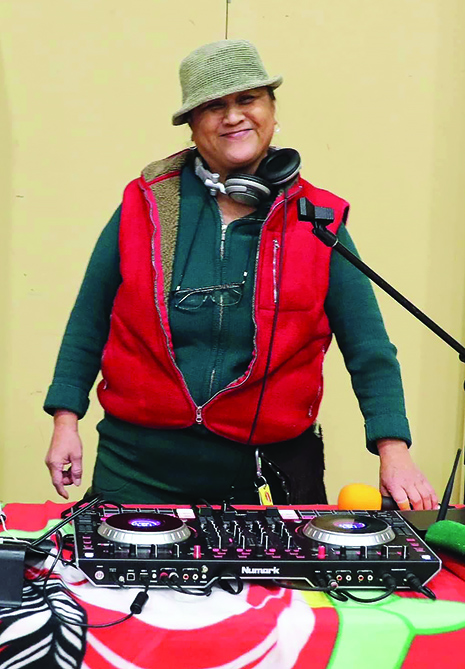
Even though she had yet to be introduced to the traditional songs of the sduhubš, the sheer knowledge that music is sacred medicine was something that she cued in on early in her journey. And coming from a line of healers and medicine men, Monie found a way to use this particular medium of beats and breaks in such fashion when she found her home behind the turntables in the early 90’s.
“It’s all about beats,” she exclaimed. “Beats are the biggest thing for DJs. I am self-taught, for the most part, because I can hear beat patterns when I listen to music. Because I know what other song would flow with it, I could be like ‘oh, that part would work really good with that song.”
She continued, “Growing up in the hood, I grew up with a lot of black folk, so I listened to a lot of R&B and Motown in the 70s. And of course, my older sisters, Esther and Muffy, were a huge influence. They loved music. When we would go buy gifts for each other, the majority of the time we ended up at the record store. In the late 70s, I was into Earth, Wind & Fire, The Commodores, Cameo – all those big musician groups where they all played real instruments, that was a huge influence on me.”
While attending Garfield High School, Monie chased her passion and joined the school’s band program. She set out to master the piano, and with natural talent and a great ear, she was content with learning just enough to get by in class. The temptation of a thrilling adolescence was too strong, and she put off learning how to read music in favor of a fun teenage social life. But her escapade with music was far from over.
During this time and through her early college years, Monie perfected the technique of curating playlists, a skill that would come in handy when she found herself in the DJ booth a few years down the line. Now keep in mind, this is the 80s, a time before mixtapes were popularized and cut together on the regular by the masses. After relocating to downtown Los Angeles in 1984 and running with a crowd of USC students, Monie started receiving numerous requests for her tapes. She dedicated time to creating the perfect mixes for her group of friends and the parties they would host. That was until 1989, when she decided to take the next step in her journey with music and invested in some professional equipment.
“One day, one of my buddies said we should have a party. And I was like, ‘I’ll go get a mixer and some turntables and play the music for the party,” recalled Monie. “I bought this Gemini mixer for like $70, it had all these little sound effects and everything on it. Next, I bought turntables for around $60, you could change the speed on it, but they were still belt driven. And last, I bought some headphones, and I started practicing.
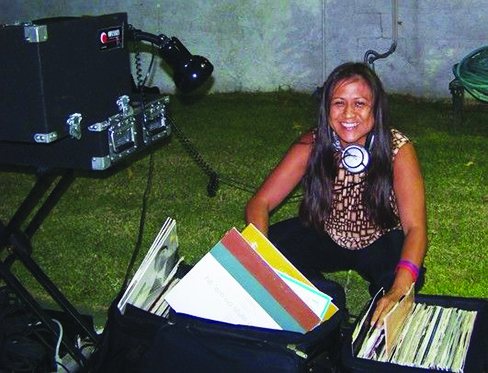
“I had a couple of friends that already had some DJ experience. One of my friends from Compton taught me a trick on how to rig my turntables, so I wouldn’t burn my motor out while trying to rotate the vinyl backwards or scratch, so it would slip really easy. Once I learned how to do that, I started spinning it back and holding the vinyl to where I could find the beat, to drop it right into the other song. I practiced that a lot and started getting really good at mixing and blending.”
Monie shared that her decision to purchase equipment and DJ her friend’s party ultimately led to more opportunities. The same friend that suggested they should host that party put Monie on game when a resident DJ at a local club announced she would be leaving her post for other endeavors.
Now, this wasn’t just an average run-of-the-mill club. No, this was the historic Jewel’s Catch One Disco Club, one of the first black discos in the US, and officially the longest running black gay bar in LA. In its heyday, Catch One hosted live performances from the likes of Whitney Houston, Luther Vandross, Janet Jackson, Rick James, Madonna, and Tulalip’s own DJ Monie.
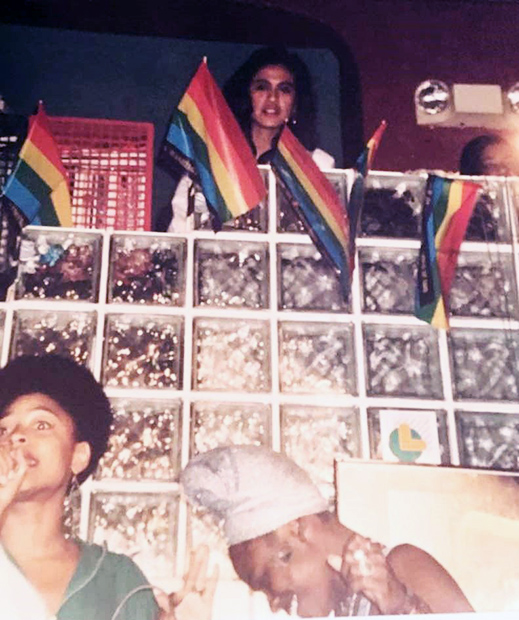
With some encouragement from her friend, Monie earned a residency at Catch One following a killer audition that left the club owner stunned. She started DJing regularly during the club’s weekly Ladies Night event on Thursdays, as well as during Friday’s Happy Hour spot at their downstairs bar.
At a time where music genres hardly ever clashed, when house was house, grunge was grunge, hip-hop was hip-hop, and R&B was R&B, Monie dared to blend, which brought people to the dancefloor in droves.
“That feeling – there’s nothing like it,” she exclaimed. “When a dancefloor is going crazy, that’s my high. I was different from all the other DJs because I would move in between genres. I’d play the popular R&B and hip-hop at the time, but then I’d mix in stuff from the 70s and 80s that I had in vinyl collection. Whenever my sister would get rid of her music, she gave me her vinyl records, so I had built a huge collection over the years. When I mixed in the old school – Prince, Cameo, Teena Marie, – the response I would get was crazy. The crowd would put their arms in the air, they’d be screaming and dancing crazy. That to me is the biggest compliment.”
Monie quickly built a name for herself, and the dancefloor would be packed each time she was on the ones and twos. She found herself in popular demand and was so well-known that she added additional sets throughout the weekends to appease frequent club-goers, while still maintaining a full-time printing job during the day. She became more comfortable and confident during her sets and perfected her craft by means of real-time experience.
DJ Monie put in four-years at Jewel’s Catch One before the gig began to lose a bit of its luster, before the dream began to feel more like a job where she was getting underpaid for her work. When this happened, Monie was also doing some personal healing following a breakup. For these reasons, she decided to take a step away from the booth and focus on her wellbeing. During this time period, which turned out to be a one-year hiatus, Monie’s presence was missed by many. Whenever she was recognized in public or caught unwinding at a nearby club, she would leave many disappointed once they found out she would not be performing a set that night.
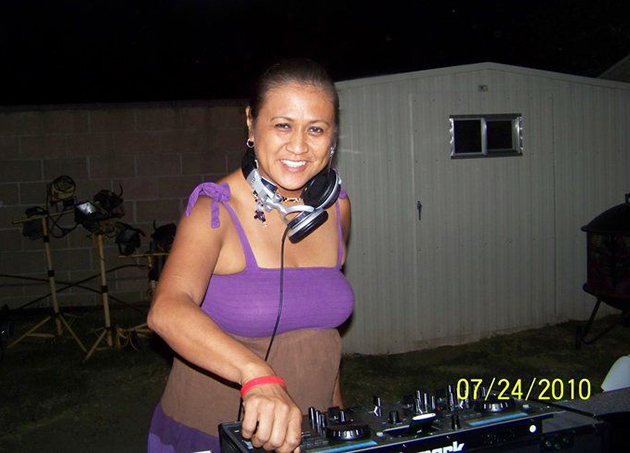
This made her return to the game even sweeter for the 90’s LA club scene. Although, this time around she decided not work the clubs at all. It was by her roommate’s request that Monie found herself once again comfortable inside her sacred space – behind a mixer and a set of turntables. Upon agreeing to DJ her roommate’s backyard birthday party, the word spread like wildfire. On the night of the party, over 400 people were in attendance and the line to get into the party stretched around the block. Amongst all these attendees were some big-name celebrities such as MC Lyte, Meshell Ndegeocello, Teena Marie, as well as women’s basketball legend and Monie’s personal friend, Cheryl Miller.
“I didn’t even get to see Meshell Ndegeocello because the place was so full,” shared Monie. “I was DJing from the back bedroom, looking through the windows out to everybody in the backyard. And that’s how I started my revitalization with DJing. That party lasted ‘til five in the morning. After that, I made everybody breakfast and my friends were still hyped up about it. So, I decided to start throwing parties. I spaced them out two or three months apart, so people would anticipate it and get excited. I averaged 300 people per party. After about a year-and-a-half, people started hiring me to DJ at their gigs. I was even throwing yacht parties at the marina. It was awesome. Those were some good times.”
DJ Monie’s sets were so epic that she once received one of the funniest requests of all time. She shared, “There was a party for one of my buddies. I was there spinning away, and everybody packed the dancefloor and was having a good time. I had someone come over and she was dancing right by me on the floor, because there wasn’t a booth set up there, we just had tables. She came over was like ‘honey can you play a messed-up song?’ And I asked, why do you want me to do that? And she said, ‘I’ve been on the dancefloor for the last six songs, and I can’t get off the dancefloor because you’re jamming too much. Play something whack!’”
Cracking up at the memory, Monie continued, “I never heard a request like that in my life. It blew my mind when she said that. I told her I couldn’t play something whack, but I’d slow it down a bit so she could make her way off the floor.”
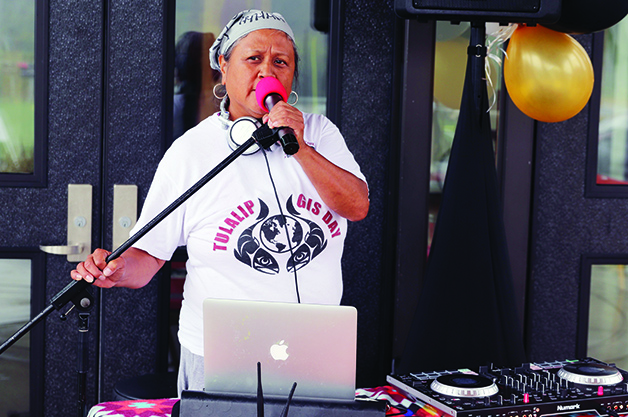
Monie would go on to have a long and fruitful career as a LA DJ, one of few women DJs in the area. Throughout the 80s and 90s, Monie’s mother, Janice Wyakes, also lived in the greater Los Angeles area. However, Janice would return to Tulalip in the late 90s following a family reunification when they got in touch with Monie’s sister, who was adopted at a young age. When the time came for Monie to return to LA, it was decided that it would be in Janice’s best interest, health wise, to stay in Washington under the care of Monie’s sisters.
A few months after celebrating her 75th birthday, Janice made her transition to her next journey in March of 2012. It was at this point when Monie began to contemplate moving home to Tulalip.
Said Monie, “I loved LA. I had been there for like 28 years. But when my mom passed away, the energy shifted so strong. I knew that I would be moving back here. And around the time when my mom passed away, my sister Muffy just started doing chemo for cancer. So, it was time for me to come back.”
Monie mentioned that she felt an energy shift. Now many of you who know Monie, also know that she is intuitive as heck. The universe did in fact begin to work its magic, preparing Monie for a return to her ancestral homelands. In phase one, Monie was laid off from her printing job, and since she was eligible for unemployment, she was able to save up for a possible move. On her sister’s advice, Monie put her name on the list for tribal housing. Phase two kicked off with a phone call, which informed Monie that a house became available on the reservation and was move-in ready.
She would soon discover that her new home was on a hill overlooking her sister’s neighborhood, which was the icing on the cake. In the summer of 2014, Monie’s permanent address officially included a 98271 zip code. But by her standards, Monie initially kept a low profile in her first few years back at Tulalip, as her sole focus was spending time and caring for her sister throughout her battle with cancer. When Muffy made her journey to the afterlife, Monie found comfort and support in her community.
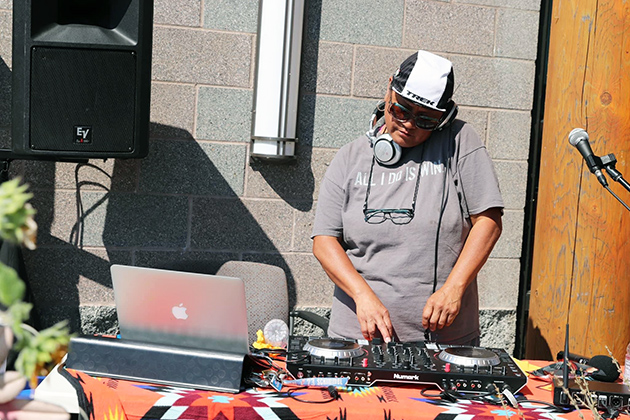
“The first couple years, I had to get acclimated to the change in weather, and because LA is a big city, I had to get used to it being so quiet except for when they have coastal jams or longhouse stuff,” she stated. “I remember the first time I ever experienced the longhouse, but it was not literally down at the longhouse. I was here at home; it was summertime in the evening. I thought who the hell is doing construction work at this time? I called my sister Muffy like, ‘who’s doing all that banging outside?’. So, she went outside, and I could see her in her driveway listening. Then she looked at me while still on the phone, and she said, ‘oh that’s the longhouse!’. I never heard that in my life. So, it took me awhile to adapt from city life to rez life.”
In her past 10 years of residency on the rez, Monie made strong efforts to be there for her people, especially when it matters most. Whether you were introduced to her at a cultural gathering, community event, on the frontlines at local rallies tackling social injustice issues, or perhaps at one of her art classes for community members in recovery, Monie has become a source of good energy, and many find themselves gravitating toward her for stimulating conversation and a hearty laugh.
Somewhere along the lines, word got out that Monie was nice on a set of turntables. Over the past few years, the local dances and community-wide celebrations have been slappin’ thanks to her music expertise. Event goers already know that it’s going to be a smash if they’re able to spot Monie and her signature setup of her MacBook Pro and her Numark digital DJ controller at the function. Her personality bleeds into her performances and her good vibes are contagious whenever she’s in her DJ element.
“Honestly, when I first started DJing events here I started questioning if Tulalip people actually dance. Because I noticed that people would bob their heads and say they loved the music, but nobody was dancing. And being a club DJ, packing the dancefloor, and having people requesting a whack song so they can get off the dancefloor, that’s what I was normally accustomed to. But one of the most fun parties I worked is when I DJed the Valentines Day party last year. People were dancing at that one. And you know anytime people are dancing, that’s what make me happy. It lets me know that I’m doing my job.”
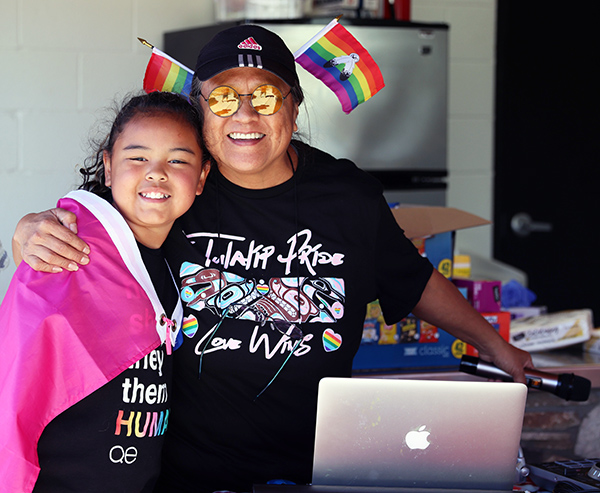
You can catch DJ Monie spinning at the upcoming 477/TANF and Child Support program’s Valentine’s Day Social from 4:00 p.m. – 7:00 p.m. at the Greg Williams Court.
Monie has also expressed a desire to share her knowledge with any youth interested in learning about the art of DJing. When asked if she had any words of advice for young aspiring DJs, she shared that it’s important to take pride in your work and invest in yourself.
She expressed, “I take pride in my reputation as a DJ, because I know that’s one of my professions. I take it very seriously. I started with vinyl. Now, with digital controllers it’s a lot easier, everything’s at your fingertips. Pay attention to your crowd and play the music they want to hear, not the music you want to play. And start training your ear and listen to other DJs because there are different techniques going on from one song to the other. Listen to mixes – how people blend, the different beat drops, the backspin to transition to a new song. I also think it’s important to use your money to invest in yourself. And for me, my DJ equipment was investing in my joy that feeds not only my soul, but also sustains my livelihood.”
Be sure to check out DJ Monie’s playlist that she curated to highlight her career as a renowned Indigenous DJ. Add the tracks to a playlist on your Spotify, YouTube, or Apple Music accounts and be sure to hit play whenever you need a good dance session or a pick-me-up.
_____________________________________
Monie’s Grooves
Curated by DJ Monie, this playlist is packed with feel good beats that are sure to get the party started! Each track also follows Monie’s journey as a DJ, from her early years collecting vinyl to her favorite jams of today!
70s
Play That Funky Music – Wild Cherry
Good Times – Chic
Bounce, Skate, Rock, Roll – Vaughn Mason & Crew
80s
Candy – Cameo
Another One Bites The Dust – Queen
90s
The Power – Snap
Poison – Bell, Biv, DeVoe
2000s
It Takes Two – Rob Base
Present Day
About Damn Time – Lizzo
Break My Soul – Beyoncé